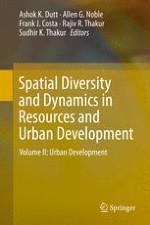2016 | OriginalPaper | Chapter
13. Hazard Risks and Social Vulnerability in Urban India
Author : Monalisa Chatterjee
Published in: Spatial Diversity and Dynamics in Resources and Urban Development
Publisher: Springer Netherlands
Activate our intelligent search to find suitable subject content or patents.
Select sections of text to find matching patents with Artificial Intelligence. powered by
Select sections of text to find additional relevant content using AI-assisted search. powered by
